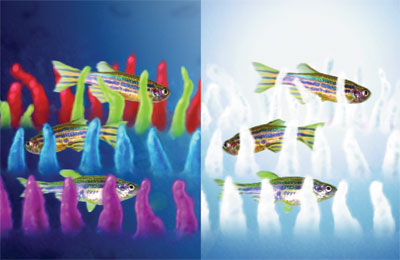Visual Pigment Reactions and Light Adaptation
When you first walk out of a movie theater into a sunlit parking lot, all the cars look washed out. In a minute or so, the dark colors deepen and the contrast is better. The reaction is called light adaptation.

UW scientists used zebra fish to study the biochemistry of light adaptation in the retina. Red, green, blue, and ultraviolet cones extend their light-sensitive outer segments into discrete layers of the retina as shown in this artist's rendition. The left panel depicts the rich pigmentation of cone photoreceptors in darkness. The right panel depicts bleaching of the pigments by intense illumination. (Art by David Ehlert).
To understand how this reaction works on a molecular level, James Hurley, professor of biochemistry, and Matt Kennedy, a graduate student in biochemistry, examined chemical reactions in rods and cones, the cells in the eye that capture light energy, The researchers wanted to account for the enhanced ability of cones to adapt to light. They studied zebra fish because their eyes are enriched with cone photoreceptors for daylight vision. Night vision relies on rod photoreceptors.
The scientists were interested in the activation and de-activation of visual pigments, which are protein complexes that absorb light and begin a chemical chain reaction. A process called phosphorylation temporarily turns down the visual pigment and thereby stalls the chemical reaction.
The researchers found that visual pigment phosphorylation is sensitive to calcium levels within the cones. In bright light, calcium levels decrease. Their findings suggest that calcium helps regulate the inactivation of visual pigments in cones. When bright light lowers intracellular calcium, phosphorylation becomes more efficient and the bleaching effect of light is reduced. This control of the visual pigment contributes to light adaptation and helps zebra fish to see in bright light.